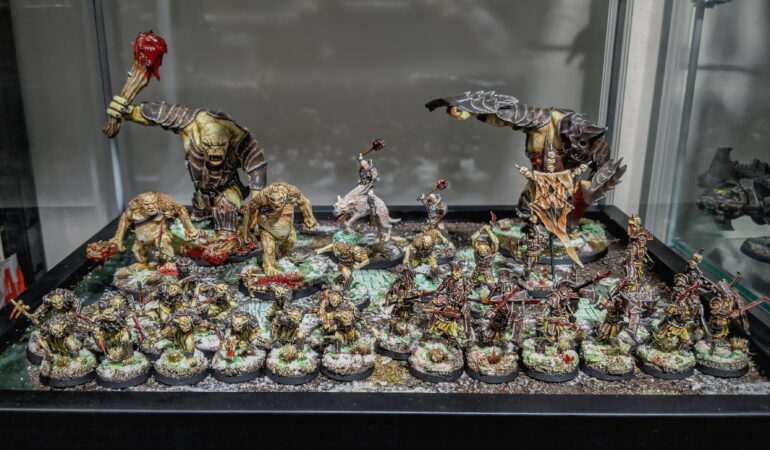
Hello internet, and welcome to another instalment of Plastic Crack! Today, I’m going to be introducing my new Azog’s Legion army. I’ve got as much to say about the army itself as I do the details of painting it, so in the interests of making this a manageable read, I’m going to stick as much of the chat about painting in the photo captions as possible. You might want to read the captions before, after or instead of the main text – or not at all if that’s something you don’t care about. With that said, this is gonna be a long one – so let’s get started!
This project should come as no surprise to anyone who keeps up with my blog. The first time I ever mentioned Azog’s Legion on Plastic Crack was in a follow up post to my Angmar army, way back in February 2019. I had just knocked out a small force of Dark Powers of Dol Guldur and I mentioned that I was interested in collecting that army one day. A few months later (June, if I recall correctly), a partially assembled/unpainted army popped up on a Middle-earth SBG trading group that I was following for a good price, so I snapped it up. Thus began my saga of procrastination.
Thing is, I’m not normally the sort of guy who splashes out on a new army in one go. I like to start small and expand in increments. Although I don’t have the time to game as often as I’d like – to the point where I will often have new projects completed between events anyway – I’ve always enjoyed the process of a slow grow army. I like to begin my new projects as an allied detachment or a skirmish warband, then expand out to a standalone meeting engagement sized force. Finally, I make one last push for the full-blown army. When I reach this final checkpoint, I allow myself to switch gears to a new project, or work on a new unit for an existing army.
I find this process helps me to stay focused and finish projects. Whether it’s some new release doing the rounds on Warhammer Community, or some new project that jumps out at me on the ForgeWorld webstore, there’s no shortage of distractions in this hobby. It takes a lot of hours to build and paint a single unit, let alone a whole army, and so the temptation is always there to start something fresh and exciting.
By not committing to the full whack from the outset, I leave myself open to tinker with my list and choice of units – this keeps me thinking about the current project, which helps keep me excited about it while I’m getting it ready for the tabletop. I don’t feel obliged to include however many of this unit because I already bought and assembled them, and I don’t exhaust all of my exciting hobby purchasing in one fell swoop, either1. On top of that, by setting myself specific army-size milestones, I protect myself against ‘failure’ should the unthinkable happen and I completely lose interest in the project. No matter what, if I can muster the will to reach my next achievable checkpoint, I’ll still end up with a usable army in some form or another. Even if it’s just a skirmish warband, an allied detachment or a small meeting engagement force, I have something useful to show for the hours I sank into the project thus far, not just armful of assembled miniatures in various states of completion.
And so when the bulk of what would become my Azog’s Legion army came to me as in one big box of miniatures in various states of assembly, I found myself in an unusual hobby position – I was intimidated. I started finding every excuse not to begin them, substituting in smaller one-off projects for existing armies or beginning a series of smaller, skirmish-sized forces instead. Back in September 2019, I first put forth intentions to begin working on them in a footnote on my Blood Bowl Orc expansion post. By October, I had started half-joking about finding projects to start ahead of the Legion. The last reference I made to this army was back in my January when I had finally completed my Blackstone Fortress set. By this point, I was being realistic with myself – they had slipped to “sometime in 2020”.
Well, I am pleased to say that as of the time I started typing this out, I have entirely cleared my backlog of Azog’s Legion miniatures (and in fact am now patiently waiting for ForgeWorld to open their doors again, so that I can add a few more!). Furthermore, I believe that I was, in fact, right to leave them until I was suitably inspired.
My long term plan has always been to take this army as the Evil counterpart to my Iron Hills for the next Scouring of Stirlingshire event. Every army for Middle-earth SBG has it’s fair share of cool looking miniatures, but Azog’s Legion is – in my personal opinion – the only army whose miniatures truly rival that of the quality of the Iron Hills. There is an undeniable quality to the sculpts of the Azog’s Legion range – from the gnarled and disfigured frame of the lowliest Goblin Mercenary to the sheer imposing girth of the Gundabad Troll.
I wanted to do this army justice, to capture the horrific nature of the sculpts. Beyond that, I wanted to impart a little of my own personal flair onto the miniatures. With my Iron Hills army, I didn’t stray too far from how they appeared in The Battle of Five Armies – they were, by and large, encased in bright silver armour, with gold trims and with brown leathers. But I still imparted a little of my personality and style onto the miniatures. The army ‘scheme’ – represented on the shields, cloaks and saddle linings – was a bright and saturated quartered orange and cream design. I also put a level of effort into the basing that I would normally reserve for characters, cavalry and monsters into every individual miniature – showcasing my signature bright blue water effect beneath a raised bed on slate to represent the treacherous but beautiful terrain of The Iron Hills.
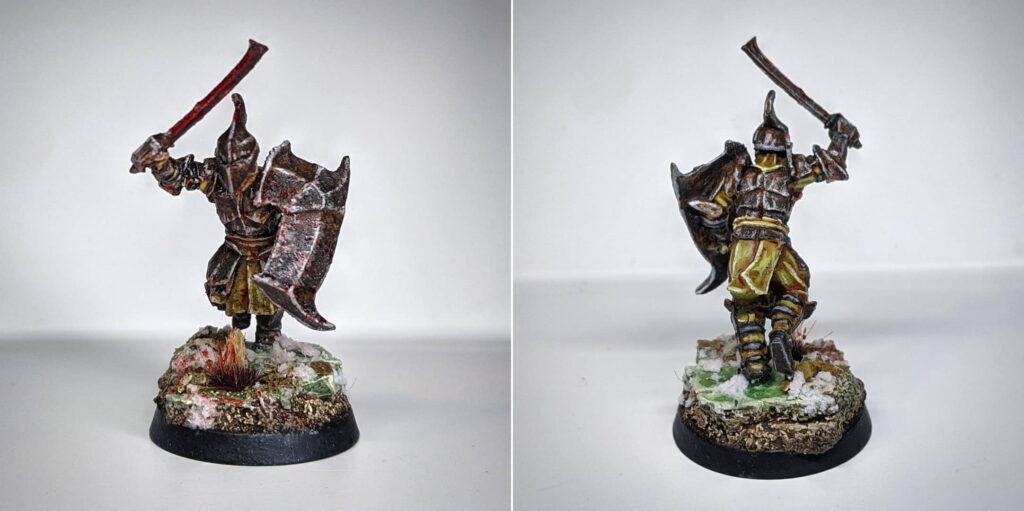
The base on this particular miniature – and several others – was built by the original owner of many of these miniatures, Andy of Deathwatch Studios. These bases came on the first 8 Gundabad Orcs and both Gundabad Trolls. I built the bases for the rest of the army to match, and painted them to blend in with the rest of my Evil Middle-earth Miniatures, using a dark brown base with Elfic Flesh drybrush and Agrax wash for the dirt, and Elfic Flesh base, Biel Tan Green wash and Elfic Flesh drybrush for the stone. This was finished with some Wasteland Tuft and Valhallan Blizzard.
For a final, grim touch I flicked slightly watered down Blood for the Blood God off a toothbrush onto the front of the miniature.
It took somewhere in the region of nine months after purchasing the models for this army before I finally my eureka moment. The idea came to me while painting my Mordor Troll for the Last Alliance narrative scenario. On that particular miniature, I had painted the armour in a particularly grimy/janky style that I had used previously on my Mordheim gang, The Squeaky Blinders. This involved using a heavy application of Typhus Corrosion over the weapons and armour, followed by a pin wash of watered down Ryza Rust in the recesses, a very light drybrush of Plate Mail Metal, then highlighting the edges of the metals with Shining Silver. I made one small change to my process on that Troll, which was to paint lots of tiny little tapered perpendicular lines across the edge, rather than a straight, flat highlight. By the time I finished my Mordor Troll, I became convinced that this was a good way to paint the metallics on my Azog’s Legion army – after all, there was an awful lot of metal to paint, and this method had them looking suitably evil – and quite distinct from the Iron Hills army that they were intended to contrast.
Following this thought process further, it occurred to me that I’d never seen a Blanchitsu-style Middle-earth army. And why not? I suppose there’s a few reasons. For one, Middle-earth SBG is based in a relatively low-fantasy setting. There’s Gods and Wraiths and malevolent forces of shadow and flame but – in the 3rd Age that The Lord of the Rings is set in – Middle-earth is pretty grounded, at least when compared to any of the Warhammer franchises. Madcap conversions like humanoid Ratmen gangsters in flat caps just don’t fit in here. Related to this, another reason is that unlike Warhammer, Middle-earth SBG’s setting comes from a series of films based on a series of novels – not a purpose built setting conceptualised for the explicit purpose of a miniatures game. The films that Middle-earth SBG is based on already carry a well established tone and aesthetic – an aesthetic that resonated with many hobbyists before they started painting the miniatures, and which has a tendency to inform their approach.
I looked over at my gang of Squeaky Blinders, sitting in the display cabinets in my hobby room. I love that little experiment with Blanchitsu. While I’m sure purists would debate whether they truly qualified for the term or not, I was thrilled with how the gang turned out – that overall aesthetic and my process for painting it. I felt like I wasn’t quite finished exploring that process, and I thought about that Azog’s Legion army sitting in a box on my shelf.
The miniature range for Azog’s Legion lends itself surprisingly well to Blanchitsu. Other than a few standouts from Return of the King2, much of the Lord of the Rings ‘Evil’ range is relatively clean – sometimes spiky, sometimes scary in it’s own way, but by and large there’s nothing really comparable to some of the the nightmare fuel that comes out of Warhammer 40,000 or even Old World Fantasy. The Hobbit, on the other hand? Now we’re talking.
Back when I had started playing Middle-earth SBG, it never occurred to me to play an army from The Hobbit. The films or factions within didn’t hold the same emotional pull for me as The Lord of the Rings, and I wasn’t all that familiar with the miniature range, having been out of the hobby when much of it was released. It had never occurred to me give it a second look until the Armies of the Hobbit book was released, and by that point I was knee-deep in my Angmar army. When I did eventually see the miniatures, my mind was blown. The first thing that captured my attention was how dynamic and formidable the Orcs looked, not unlike Uruk-Hai but with a decade of improvements in miniature sculpture working in their favour. But moving from Games Workshop over to ForgeWorld’s website was when everything really hit me – the physical deformities and inhuman physiology of the Goblin Mercenaries, the Troll Brute with prosthetic morningstars for hands and reigns attached to his empty eye sockets. Azog himself is literally wearing a loincloth of humanoid faces stitched together. That was when I knew that this would be my next Evil army for Middle-earth.
And now, I knew how to do those miniatures justice.
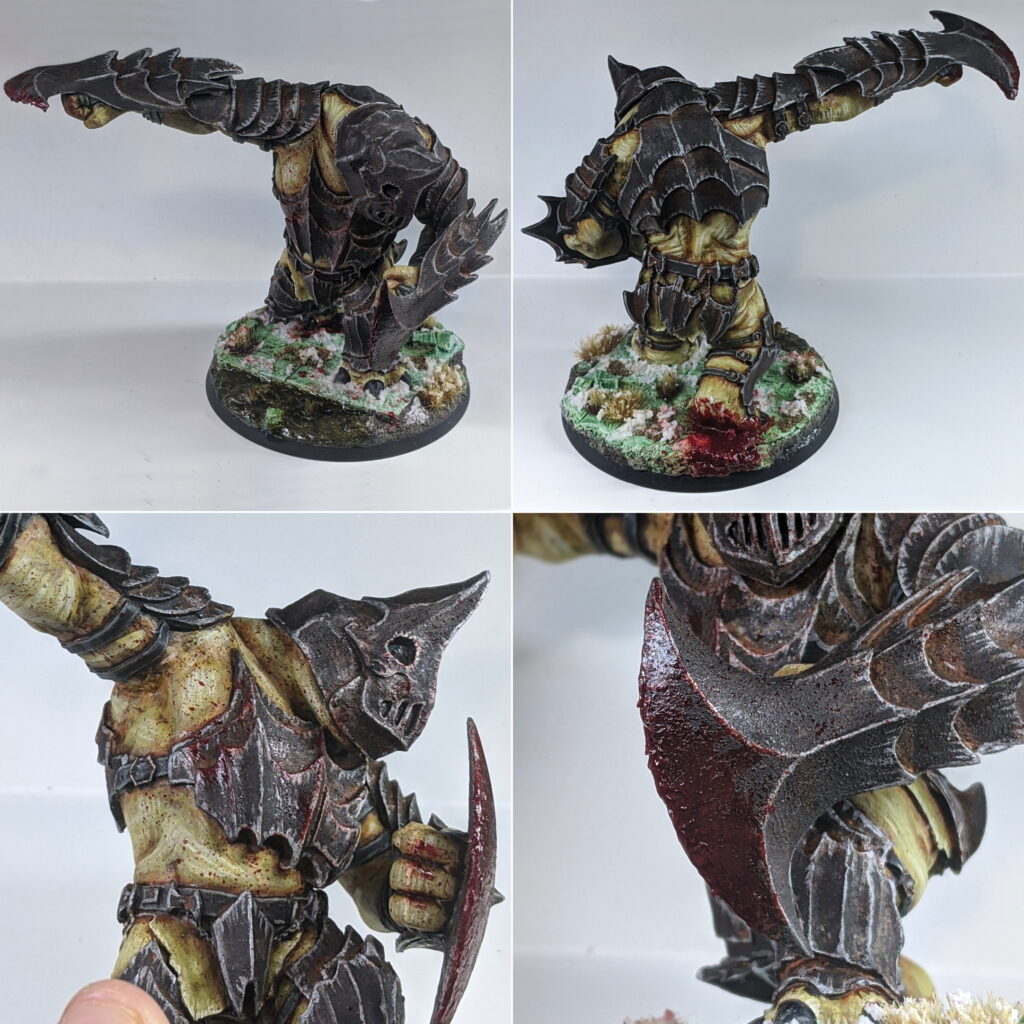
Wherever possible, I tried painting most of the skin with long, thin strokes in a single direction to try and impart a little more texture from the muscle fibres. In places, I went back and applied pin washes of Fuegan Orange to help re-establish the warm orange tones where it started to appear a bit brownish. This was followed up by another layer of feathered Dead Flesh and Elfic Flesh to help blend the tones back in.
The straps were given a bit more care than the quick single stroke layers of grey on the Gundabad Warriors – in this case, they were painted Charcoal, edge highlighted with Mechanicus Standard Grey and again with Wolf Grey, before getting washed with Agrax Earthshade to impart a slightly brownish, dark-leather feel. Finally, the finest edges would be picked out with a little Elfic Flesh to bring up the contrast.
After a quick test miniature in the form of a single Gundabad Orc, I decided just to jump straight into a Gundabad Troll with Scythe Gauntlets. Under normal circumstances, I’d try and get a few more basic Troops under my belt before ‘rewarding’ myself with a big, bad monster like this; taking this approach let’s me get comfortable with my method on more forgiving miniatures that will generally appear in numbers. These were not normal circumstances, however. Not only did I have a larger number of miniatures sitting built, primed and ready to paint on my desk3, but among their numbers was a second, rather similar miniature to this. I didn’t want to be tempted by batch paint these big awesome monsters, so it seemed like a good idea to take the simpler of the two and use it to kickstart my motivation to paint the army by painting something big and exciting.
Painting details for this guy in the caption, but I do want to talk about the blood effects on this guy here. With my Mordor Troll, I had experimented with mixing Blood for the Blood God with Vallejo Water Texture to create dripping blood effects, and I feel like this particular Gundabad Troll is the closest I have come to proving the worth of this technique. For one, there’s the Scythe Gauntlets. On the outstretched arm, I wanted to create a kind of dripping effect, with the blood beading off the razor edge, slick with gore. This turned out alright. The beading had to be relatively subtle anyway, which accommodated nicely the shrinkage that happens as the water texture cures. The main winners however, were on the Troll’s foot and his other scythe gauntlet. As the miniature was advancing, I wanted it to look like he had moved on from his most recent kill, so painted a trail of blood from his back foot, as if he’s just advanced after stepping on the corpse, dragging his heels and leaving a trail of gore as he goes. As with the scythe gauntlet at his chest, I could have achieved this effect simply by painting on Blood for the Blood God out of the pot, but the effect of mixing it through some water texture meant that some areas come out looking thicker, like they’re slick with not just blood but pulverised flesh. The difference is subtle, but adds a nice texture to things.
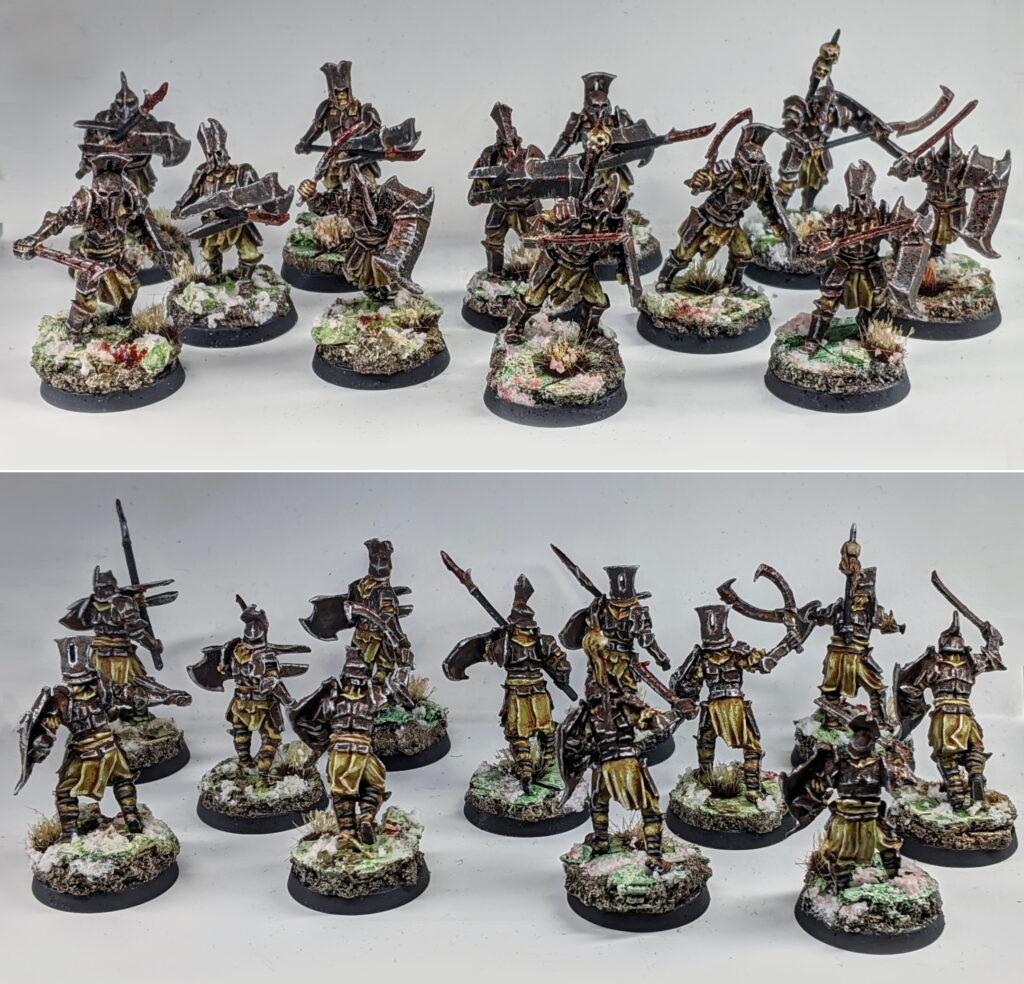
With the cobwebs well and truly shaken off, I decided it was time to smash out some more Troops. The initial batch of Gundabad Orcs that I bought with this army numbered around 10 (4 Spear/Shield, 6 Sword/Shield), so I painted 8 of these to begin with – you can see the initial 8 over on my Instagram. It wasn’t until I finished painting everything else that I remembered I had another box of 12 Gundabad Orcs on the sprue – purchased ‘just in case’ shortly after I received the bulk of the army in the post. A quick trip to the attic later, I started building my remaining four.
While perusing the sprues, I noticed a few heads that weren’t on any of the initial 8, so made an effort to build the most under-represented sculpts. I also swapped out the heads on the two ready-built sword and shield Orcs, to maximise variety in the group.
It’s a strange experience, building out an army from a core that you purchased 2nd hand. When you buy everything new, you learn the kits as you go – you know what comes from where, what the minis look like, and what you need to do if you want to convert a little variation into them. As I received the bulk of my Orcs built and undercoated, it never really occurred to me that there was anything unusual about them until I started building the extras. I shortly learned that Andy had reposed some arms and switched some heads around to create a little variation. He’d also used the ForgeWorld Gundabad Upgrade Set on a few of them – this was pretty obvious given the existence of the banner bearer, but it wasn’t until I was putting together some spearmen of my own that it occurred to me that the basic Gundabad Orc Warriors kit doesn’t come with shields for the spearmen. With ForgeWorld still closed, and me only needing a couple of shields for the Spearmen anyway, I picked up a a pair of Gundabad Orc shields from an eBay bitz seller. It took a couple of weeks to arrive, but eventually I received them and finished off my last 2 Orc Warriors long after the fact. That, and my own laziness is the main reason this post didn’t go up a fortnight ago.
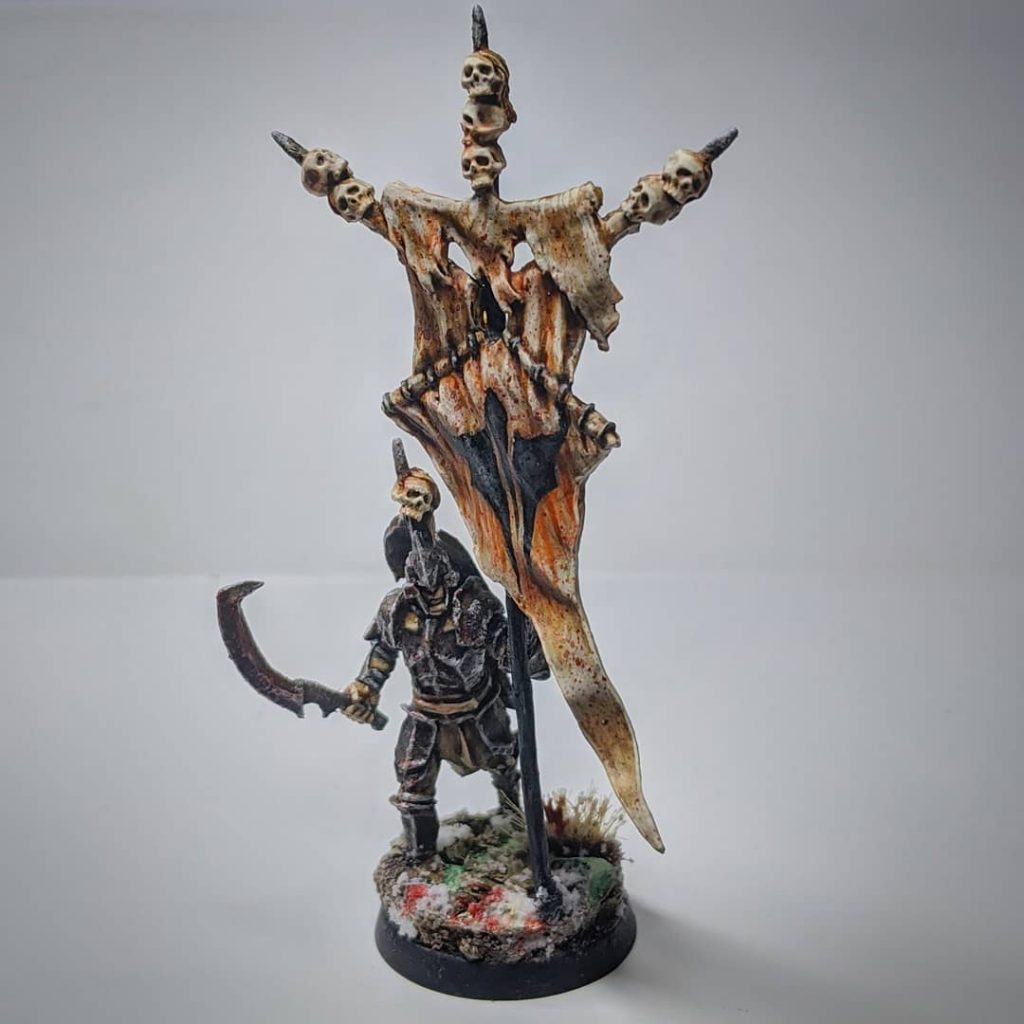
The freehand Mt Gundabad emblem was painted with watered down Black over a few layers, then built up with a little Elfic Flesh mixed in on the raised areas to prevent it from looking too flat. I carefully washed with Agrax Earthshade to help blend the layers of highlights and dull it down when it started to read more as grey. The reddish streaks under the banner were done – very carefully – with Fuegan Orange, which is such an opaque wash that I was able to paint it over the banner in a single, careful layer.
After I finished up the basic Orc Warriors, I didn’t want to jump right into a horde of Goblin Warriors, so I thought a nice middle ground would be to paint the armies banner bearer.
I have to admit, I was nervous about this one. By this point, I was feeling really good about the army. Between my converted armoured Azog on White Warg, my big armoured Troll and my block of Gundabad Orc Warriors, it felt like I was really gaining momentum with the army – and I was really happy with how it all looked together. The standard felt like a make or break moment in my eyes – unlike the Iron Hills banner, there was no sculpted detail to lean on, and I’ve never been especially comfortable with painting freehand. The upside, however, was that this was that the banner itself was a wonderfully bleak looking sculpt that would suit the aesthetic of the army perfectly.
All in all, I’m extremely pleased with how it turned out in the end. The banner material itself turned out exactly as I’d hoped, full of fiery sepia tones that compliment the brownish green of the uniforms or the pale greenish yellow of the fleshtones. When I started freehanding the banner, I was terrified I was going to muck it all up – and so I built up my outline in fine, thin layers that I could relatively easily clean up should I make a mistake. Eventually, the emblem of Mt Gundabad took shape. I filled it in and layered in a little lighting. When I was finished, it still looked a little off – like there was too much empty space. To offset this, I took a little Fuegan Orange and painted little streaks coming down the sides of the emblem as if it was weeping, or bleeding. Going over an already orangey/sepia background, the effect was just subtle enough that it didn’t take anything away from the overall shape of the emblem, but helped fill out up the empty space nicely – it made all the difference.
Looking at the the above image, I’m only just realising now that the banner itself is in the shape of the very logo I was freehand painting. Huh…
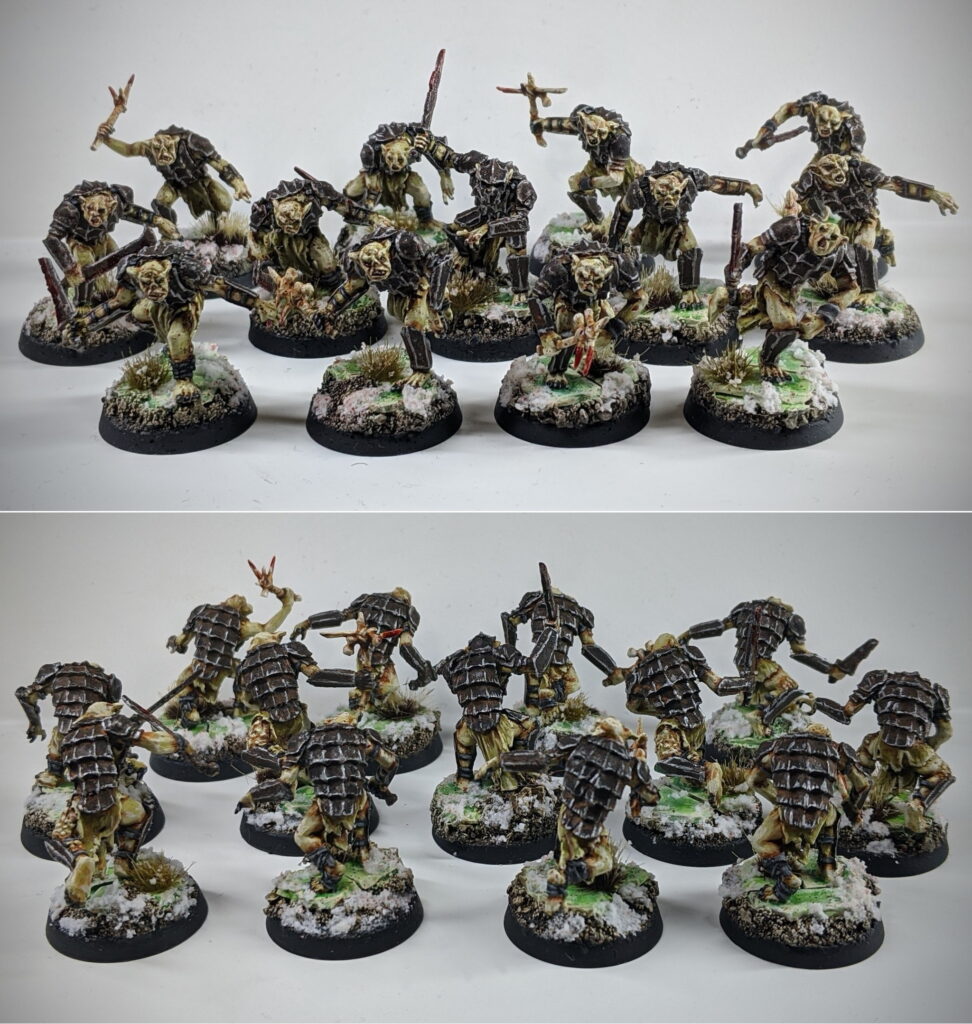
I have to say, I’m quite happy with how the feathered highlighting looks on the layered plate mail on the Goblins’ backs. There’s something vaguely insectoid about them, and to me it kindle of resembles how folk with more patience than me paint their Tyranids.
Having enjoyed my time labouring over a single miniature for a while, it was time to get back to batch painting. Next up on the table was a warband of 12 Goblin Mercenaries and a Captain to lead them.
An “interesting” fact about these Goblin Mercenaries is that when I received my box of 2nd hand miniatures in the mail from their previous owner, one of the Goblins was missing an arm. After combing through the contents of my box several times (in case I had miscounted or something), I shot Andy a quick PM with some photos explaining the situation. To his credit, he not only refunded me a fiver, but also mailed me out some bitz free of charge to fix it myself. This turned out be the entirety of his leftover Gundabad bitz, including the spare weapons from Gundabad Berserkers, the various heads and trophy racks left over from the Gundabad Upgrade Set, the dead Iron Hills Dwarf from under the boot of one of the Gundabad Ogres (which I used on base of my mounted Azog), leftover weapon options from the Goblin Mercenaries kit, plus a plastic dead/dying Hunter Orc, for replacing the arm.
Meanwhile, my friend Ross managed to pick me up a 2nd hand plastic Goblin Town mini from a wargaming jumble sale at a local gaming expo for 20p or something. The mini was (poorly) painted, and in rough shape with a little bit of sprue still on the arm – but given that all I needed it for was a shoulder, bicep and forearm, none of this especially mattered. I cut off the arm from the plastic Goblin, scraped off the paint and mould lines, swapped his weapon hand with a resin Goblin Mercenaries pick hand and stuck it into the arm socket with a little green stuff. Unlike the rest of the Goblin Mercenaries, this arm lacked an armoured pauldron or bracer – but given the ramshackle nature of the rest of these minis, I don’t think it’s especially noticeable. Have a look for yourself – he’s in the top left of the front and back photos above. Did you notice that first time around?
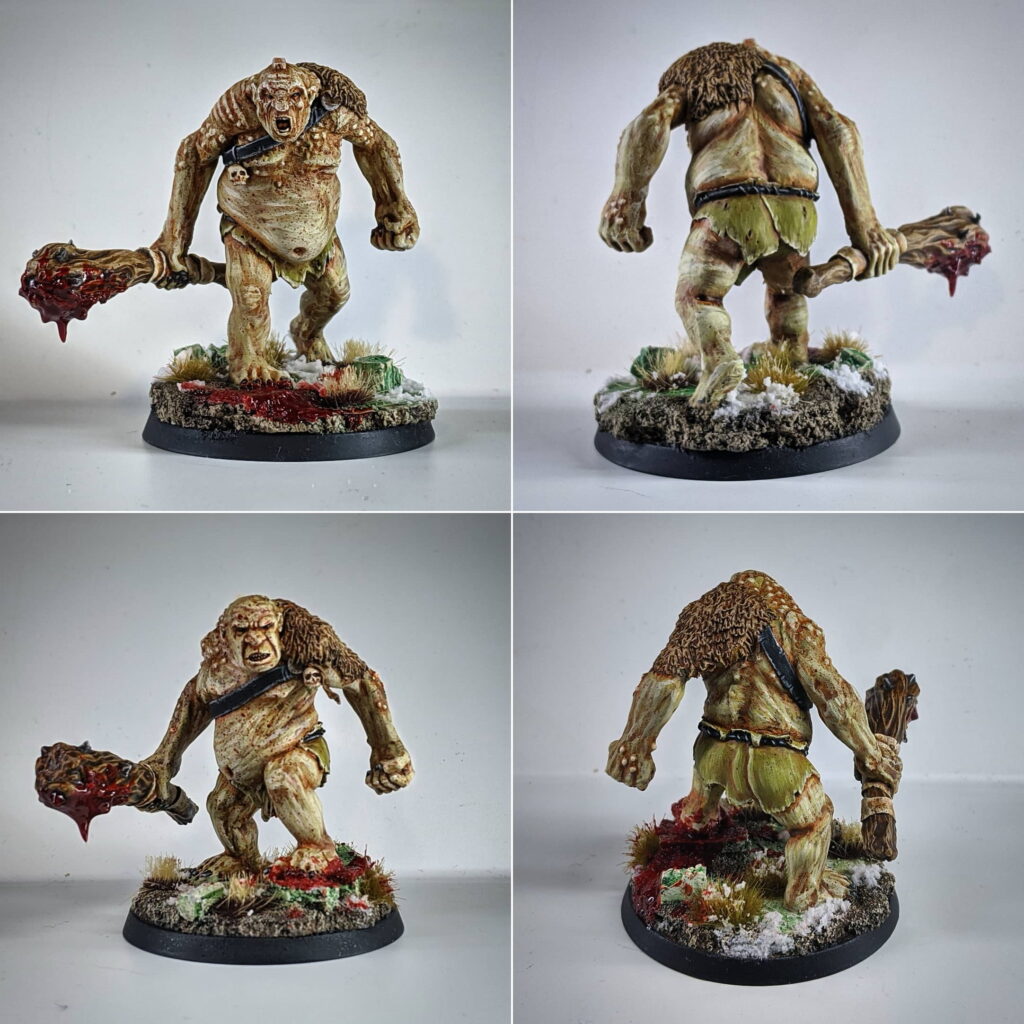
In the end, these guys just ended up having a lot more Fuegan Orange and Elfic Flesh, with considerably less of the Dead Flesh midtone showing through. This gives them a warmer. more fiery appearance than the pale, leathery skin of the Gundabad Trolls.
The next two miniatures that I finished for this army are two Gundabad Ogres that I have been affectionately referring to as ‘Bert’ and ‘Ernie’.
These miniatures are somewhat interesting in that I received them pre-converted – the shoulder pelts and leather bandoleers do not come as standard on Gundabad Ogres, nor does Bert’s mohawk. I presume that this detail was sculpted onto the miniatures by Andy as a way to differentiate the two from his vanilla Gundabad Ogres (which I had the pleasure of playing against at my first Middle-earth tournament, One Last Adventure 2018 at Common Ground Games), but either way it was a cool addition to the miniature that I appreciated. The fur texture was very similar to the sort of thing I’d sculpt myself for my Space Wolves, but I have to say I was a little blown away by the bandoleer – which was super cleanly sculpted save for a few intentional little nicks and scuffs – as well as the mohawk on Bert. As a matter of fact, it’s only as I started writing this paragraph that I realised that mohawk was sculpted on in the first place. Andy, if you ever read this – top notch work!

We’re on the home stretch now. This one is a quick Gundabad Orc Captain that I kitbashed from a Gundabad Orc Warrior and some of the bits Andy sent me. Not a lot to say here – I liked his pose, so I swapped out his head for an Orc Captain head with the fancy helmet crest from the Upgrade Set, gave him a pair of trophy racks to increase his bulk a little and switched out his sword (which had snapped off in transit anyway) for a Gundabad Berserker axe. This axe is a little meaner than the ones in the upgrade set (with those vicious little teeth at the back), although so was the hand it came attached to. When I decided that it looked a little large and unnatural, I switched the hand back out for a Gundabad Orc hand, cut the sword and hilt from it, and swapped over the axe and hilt from the Gundabad Berserker. The handle was still a little short (having come from a larger hand), so I made up the distance with a tiny little bit of green stuff. Fiddly, but I’m happy with the Captain, and it’s nice to have a comparatively inexpensive means to get some more Might on the table.
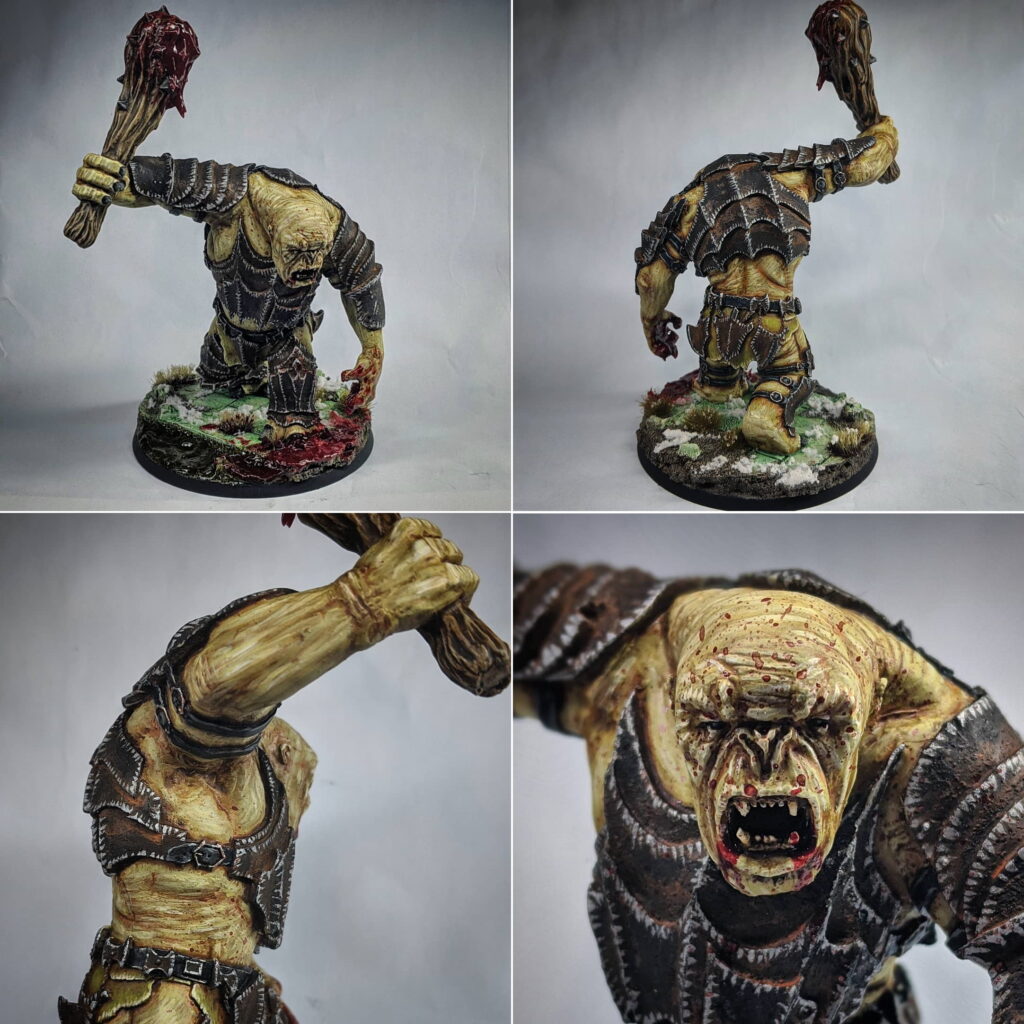
While I intended for the blood effects on my Scythe Gauntlets Troll to convey that he was advancing, having already mutilated whatever poor soul crossed his path, I wanted this one to look like he had just discarded his foe, having picked them up and pulverised them with his club. To that end, I made the club slick with blood texture and left a thick puddle of gore at his foot and dripping from his free hand. I’m mostly happy with it, but I think I went a little overboard on the puddle, and I had hope the gore that spilled into the water effect on the base would cure a little more clear than it did – instead it looks a little like the blood is sitting on top of the water, which isn’t ideal. Still, I’m otherwise really happy with this mini – I’m especially thrilled with how the flesh turned out.
Here he comes, the last of the miniatures that I bought from Andy and contender for chonkiest boi in the whole damn army – a Gundabad Troll with Crushing Club.
Keen eyes might have noticed my Trolls have had their heads swapped. These heads are not supplied as an optional extra – you need to buy with the Club Troll and the Gauntlets Troll if you want to put a helmet on the Scythe Gauntlets mini and vice versa. Way back before I had started this army, I didn’t really like the bare headed Troll – I liked the idea of a fully armoured, helmeted Azog’s Legion army, resplendent in full plate everywhere. It was that compulsion that had originally captured my attention when I saw these miniatures listed for sale – I thought ‘here’s my opportunity to buy a helmeted Troll with Scythe Gauntlets, so I can buy a new one with Crushing Club and have two helmeted Trolls’.
As is often the way with these things, I figured I could get a better deal if I turned around and said “Hey, I’ll give you X amount for the lot” – and the promise of saving a few quid here and there was a bit much to resist. I ended up with both Trolls anyway. On this occasion, I am so glad that things worked out the way they did.
I get why ForgeWorld sells these miniatures with they heads that they do. The Scythe Gauntlets Troll arguably has a surplus of hardware, thanks to the gauntlets. Likewise, the arguably more ‘crude’ club wielding Troll benefits from the addition of a little extra metal plating. But subtlety has never really been my strong suit – and I can’t help but think that the metal fisted Scythe Gauntlets Troll looks way better with a matching plate helmet, while the Troll with the big heavy stick suits that screaming fanged maw perfectly.
I also gotta say, painting that head and face was just waaaay more fun than painting the helmet. Not the quickest job of the two, but a lot more rewarding.

And finally, we have the Big Bad himself, Azog the Defilier. I won’t lie – I wasn’t thrilled about painting this miniature, and the fact I left him to the very end wasn’t so much “saving the best for last” as productive procrastination. The primary reason for this is that, well, I already painted this miniature months ago. Moreso than any dismount before – I painted this exact miniature.
One downside of painting my mounted Azog so long ago was that I had not yet decided on this paint scheme. I kind of figured it was completely permissible for the titular character of Azog’s Legion to have a crisp, clean black armour instead of the grubby plate of his minions, so I went ahead painted it the same way. I did apply some lessons that I learned first time around on the mini. I gave him an extra coat of Nuln Oil on the armour to further darken it, and did my initial pass of edge highlights with Plate Mail Metal – Shining Silver reserved for the corners and sharp edges to help them pop.
One element that I did change was his creepy stitched-faces loincloth – I painted that in the sickly Blanchitsu green colour scheme of the rest of the army, and went back and amended Mounted Azog’s loincloth to match.. Unfortunately, repainting this already fine detail over a finished, varnished miniature resulted in a little detail getting obscured on Mounted Azog. I may go back with a little Biostrip 20 on a cotton bud and redo that sometime.

Whew, we made it! At long last, that is everything I managed to finish for this army – for now! Above is a little group shot of the army as it appears in my display cabinet at home. All told, I think that everything I featured here today is just shy of 900 points.
So, what’s next? Well, those of you who are paying attention probably noticed that this is only Part One of The Legions of Mount Gundabad. The eagle eyed among you will also have noted the three Gundabad Berserkers in the family photo above – the first three of these were painted somewhere between my 2nd Troll and Azog on foot, but let’s face it – three is way to few for an army, right? Part Two – an comparatively lightweight entry4 – is coming hopefully not too long after ForgeWorld opens their doors for business once again. I want to get my hands on a Troll Brute, and another three Berserkers. It may also feature Bolg? I dunno. Maybe.
In the meantime, I have some more Mirkwood Elves to paint for Middle-earth next. Rather than push for 800 points of pure Iron Hills for Scouring, the new plan is to bring along Thranduil on his glorious Elk steed, along with some Palace Guard and a couple Mirkwood Cavalry to keep pace. I have some interesting plans to tie together the army colour scheme and basing whilst maintaining some degree of individuality. Let’s see if I can pull that one off, eh?
But until then, as ever thanks for reading and happy wargaming!
1 Let’s not deny the truth here – miniature wargamers love to buy miniatures. If you buy everything you need in a single go, you have no more purchases to look forward to receiving and unboxing – and undoubtedly start looking towards your next project.
2 Honestly, Gothmog’s weirdo lumpy tumour head kind of freaks me out… but not as much as The Mouth of Sauron. Shudder.
3 I started the project with the following built, based, primed and ready to paint: Azog on foot, 8 Gundabad Orcs, a Gundabad Orc Captain and Standard, 2 Gundabad Trolls, 2 Gundabad Ogres. Additionally, I had a further 4 Gundabad Orcs, 12 Goblin Mercs and Captain and 3 Gundabad Berserkers needing built and/or based. Barely more than a couple units in Age of Sigmar terms, but it’s a lot to chew on for Middle-earth.
4 A wiser man might’ve held back a couple of units – Azog on foot, and the Crushing Club Troll perhaps – to keep this article shorter and beef up the second part. However, given the uncertainty about whether ForgeWorld will even reopen and ship new orders, I’m not keen on potentially sitting on content for months. I’m way too unprofessional impatient for that!
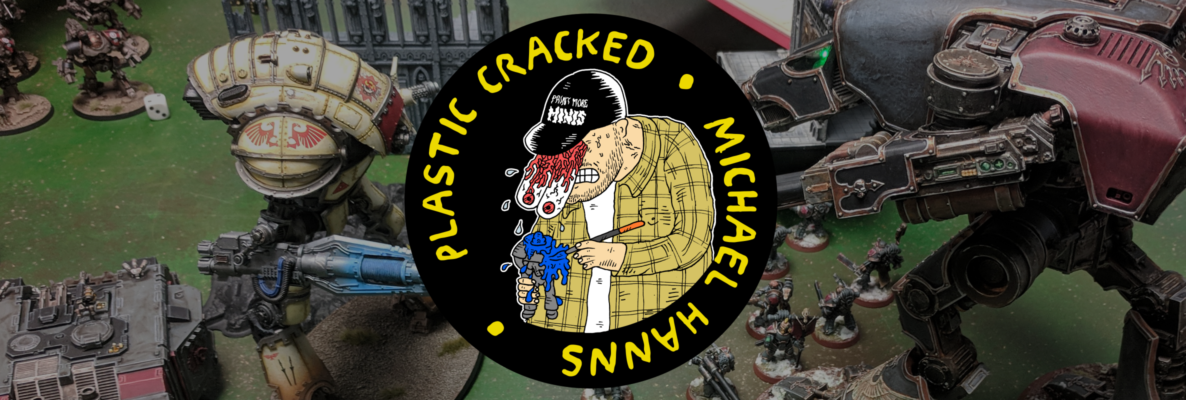
Excellent, excellent work